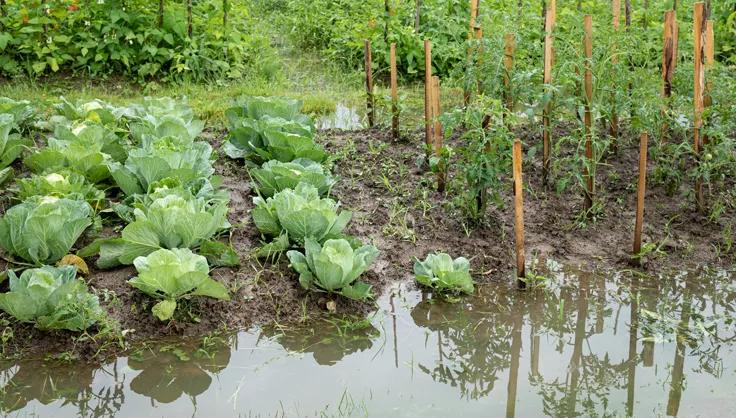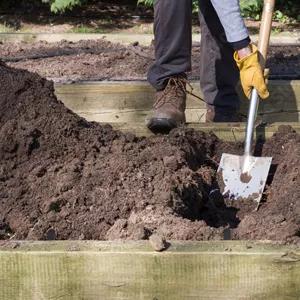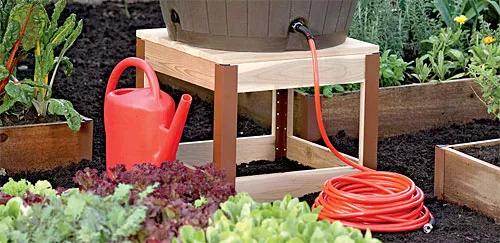Climate Resilient Gardening: Too Much Water
How to prep your garden before a big storm and recover after extreme weather

There is no doubt about it, our climate is changing. While some regions are getting hit with extremely high temps, others are seeing major rain and flooding waterways. And while our gardens appreciate a regular drink of water, heavy storms and serious flooding are proof that yes, maybe there can be too much of a good thing.
Prepping Your Garden Before a Big Storm
Is there a lot of water in the forecast? First and foremost, take steps to protect yourself. If flooding is imminent, do not hesitate to get yourself to safe ground. Nature is remarkably resilient — gardens can be rebuilt, and seeds can be started again.
Here are three easy ways to prep your garden before extreme weather:
1. Stake tall plants: Additional support for your tallest plants can prevent breakage. If you already have stakes or other plant supports in place, you can add extra ties to further secure plants, and use Earth Staples to further bolster supports.
2. Cover small plants: Prevent (or at least reduce) rain and wind damage by covering vulnerable seedlings with garden fabric, cloches, overturned pots, buckets, bowls — anything that provides a barrier will work in a pinch. And be sure to weigh them down and anchor them in place, using rocks, bricks, or Earth Staples.
3. Wrap shrubs and young trees: Though they may be bigger than your standard garden tomato, shrubs, trees, and vines are just as vulnerable to storm damage. Wrapping them in a strong fabric like burlap and tying them securely with twine can protect branches from snapping and vines from tangling or getting blown off their supports.
Gardening After the Storm
Once you’ve ensured that you and your home are safe after a major storm or flood, it’s time to check the garden. A brief, heavy rain will create a mess, but your plants will likely be ok. However, heavy flooding can do major damage. Moving water can wash away plants, and standing water effectively chokes out roots. Waterlogged soils prevent roots from taking up oxygen, and long term lack of oxygen will cause most plants to wilt, lose leaves, rot, and die back. With their vast root systems, trees and large shrubs can typically recover a brief flooding. However, seedlings and brand new transplants are especially vulnerable.
 Resist the urge to dig in your flooded garden right away — give soil a little time to drain and dry.
Resist the urge to dig in your flooded garden right away — give soil a little time to drain and dry.- Remove any major debris, like mud and branches, that may have accumulated on your plants, but then limit the amount of additional walking you do to avoid compacting the soil any further.
- It will be tempting to replant things right away but resist the urge! Digging in heavy, wet soil will only make things worse — wait, and let soil drain thoroughly.
- Once your plants have started to recover and the soil is drier, prune any damaged or rotten shoots.
- Potted plants that were inundated by floodwater can be removed from their containers and planted up again in fresh potting soil.
My Garden Flooded — Can I Still Eat What I Harvest?
A garden hit by heavy rain is safe to consume; just wash harvests thoroughly before eating. Edible plants that have been inundated by heavy flooding are generally not safe to eat. Depending on where you garden, floodwater can carry untreated sewage, landfill leachate, bacteria, and oil — these contaminants can cause serious illness.
- Leafy greens and any fruits normally eaten raw (i.e. strawberries and melons) that were contaminated by flood water should be discarded.
- Warm-season fruits (think tomatoes, peppers, and eggplant) that develop from flowers formed after the flood waters dry up are typically safe to consume.
When in doubt, throw it out!
If you want to replant your garden after a flood event, but are concerned about chemical contamination, you may want to test your garden soil first. Contact your state or county cooperative extension office to inquire about soil testing.
Long Term Protection for Wetter Weather
At this point, we know that extreme, unpredictable weather is simply going to be a part of our lives, so with that in mind, here are three helpful ways to adapt your garden for a hyper-hydrated future.
 The Rolling Patio Garden is made with rot-resistant cedar and has casters for easy relocation during heavy storms.
The Rolling Patio Garden is made with rot-resistant cedar and has casters for easy relocation during heavy storms.Raise the Roots
Raised beds aren’t completely immune to flooding — but they will drain faster than in-ground gardens. Alternatively, consider switching solely to container gardening. Rolling planters are particularly easy to roll indoors when rough weather is in the forecast.
Embrace the Rain
If you live in a flood-prone area, lean in to your soggy situation. Choose water-loving perennials and shrubs for your landscape gardens. Our favorites are irises, summersweet, and willows — but select varieties that will be happy in your hardiness zone.
Design with Water in Mind
Find ways around your home and yard to capture the rain and divert it away from structures. Rain barrels are useful ways to collect water from the roof and save it for drier times. If you feel like digging, consider creating a rain garden to help capture and slowly filter stormwater runoff. Choose a site that receives plenty of sun, is at least 10 feet away from your house foundation, and is not located on any septic tanks or leach fields.
A changing climate may change the way we garden, but it does not have to lessen our love of growing!

With a rain barrel and rain barrel stand, gardeners can collect rain to store and use in drier times.
Print this Article:
Get the Dirt
Stay up to date on new articles and advice. Please fill out the information below.

